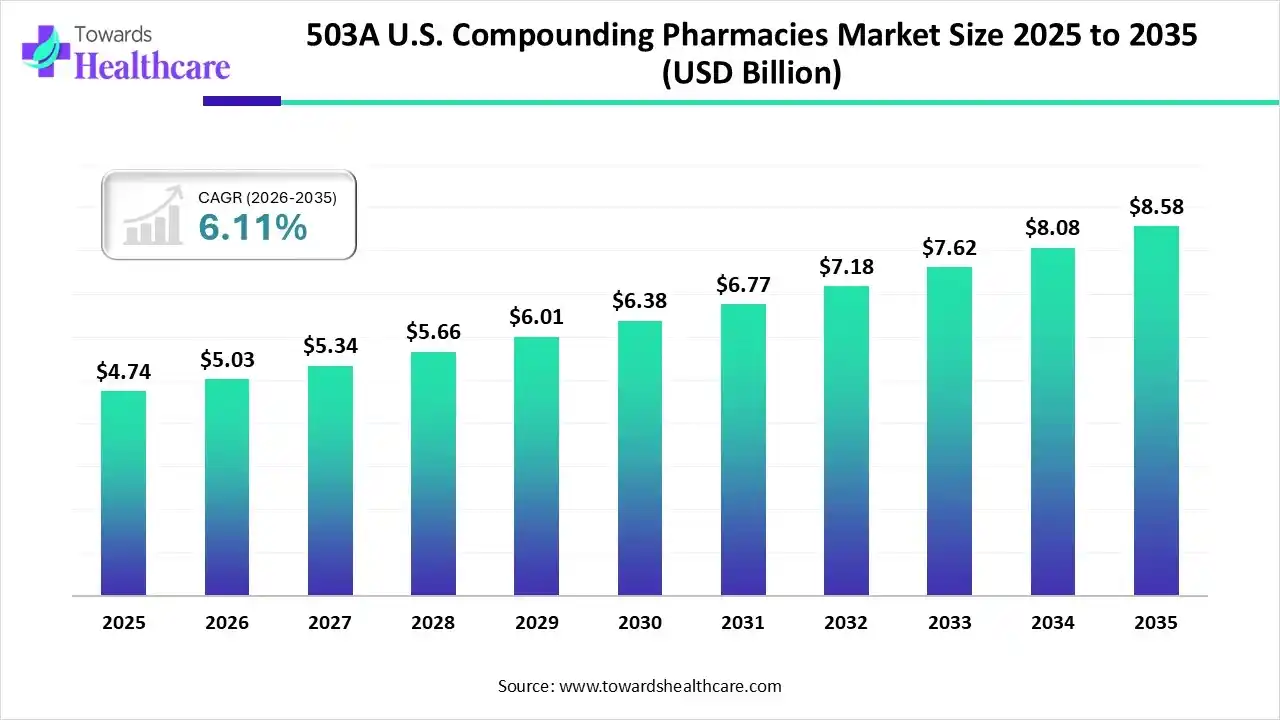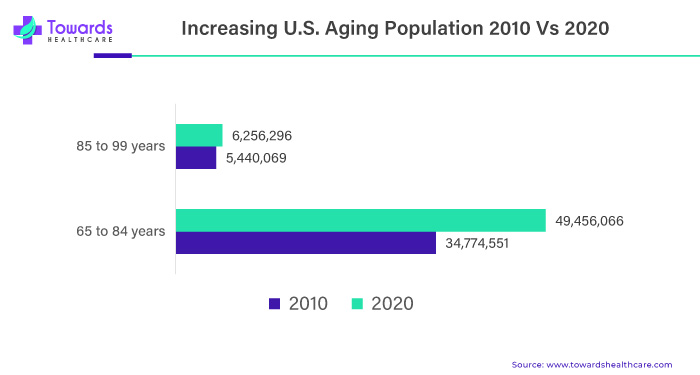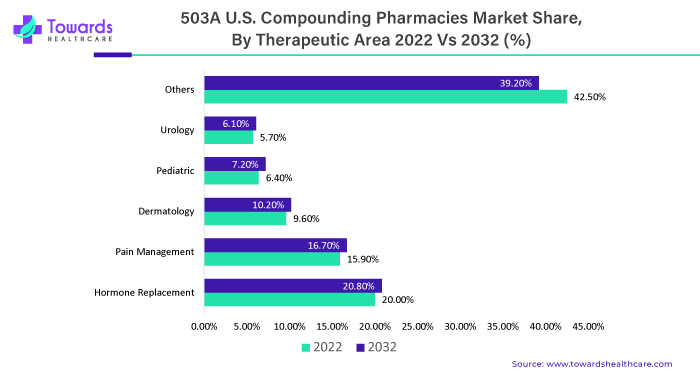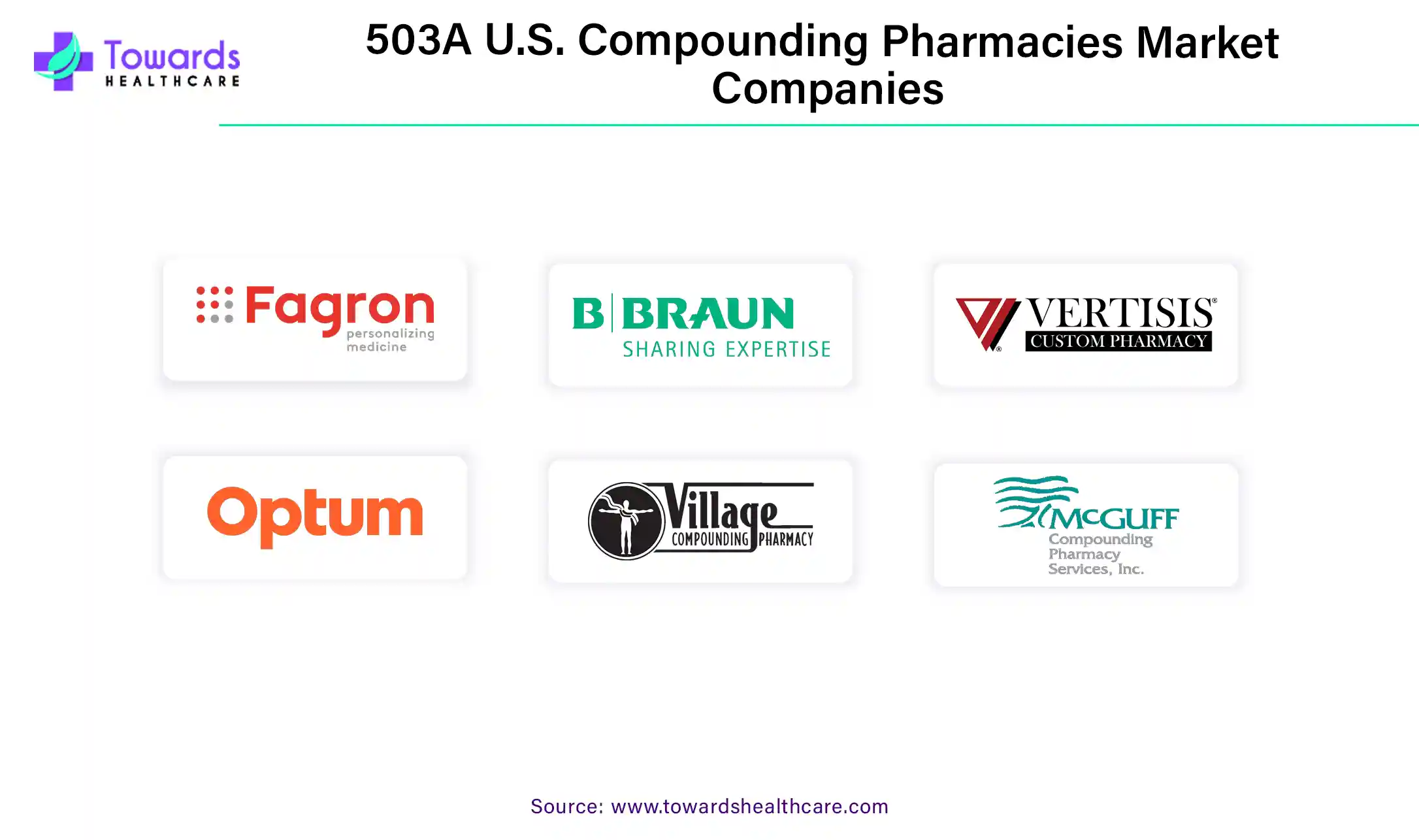January 2026

The 503A U.S. compounding pharmacies market is projected to reach USD 8.58 billion by 2035, growing from USD 5.03 billion in 2026, at a CAGR of 6.11% during the forecast period from 2026 to 2035, increasing demand for personalized, convenient and accessible care.

| Key Elements | Scope |
| Market Size in 2026 | USD 5.03 Billion |
| Projected Market Size in 2035 | USD 8.58 Billion |
| CAGR (2026 - 2035) | 6.11% |
| Market Segmentation | By Product, By Sterility, By Therapeutic Area, By End-User, By State |
| Top Key Players | Triangle Compounding , Fagron, B. Braun SE, Pencol Specialty Pharmacy, Vertisis Custom Pharmacy, Optum Inc, Pavilion Compounding Pharmacy, LLC., Village Compounding Pharmacy, McGuff Compounding Pharmacy, Wedgewood Pharmacy |
The FDA has elected 503A compounding pharmacies as those pharmacies that compound medicines as per prescriptions particular to patients and must adhere to USP and other regulations as mandated by state boards of pharmacy. 503A facilities are not allowed to manufacture in large batches and they are meant to produce and dispense for home use only. The government has employed some regulations for compounders to strictly follow while compounding pharmacies. Regulations suggested for 503A include USP <795> and <797> along with state board of pharmacy regulations.
Such type of compounding can be done in community pharmacies, hospital pharmacies, and in physicians offices. The United States Pharmacopoeia (USP) offers environmental standards for 503A compounding pharmacies in the United States, recommending that compounded medications be produced in specified spaces that are suitably constructed to facilitate the sterile or nonsterile processes, which comprises offering correct storage for those preparations and the right circumstances (e.g., regulated temperature, light, ventilation, security, and moisture).
Quality standards Exempt from current good manufacturing practice (CGMP) requirements, but not from other quality requirements, such as the prohibition on preparing, packing, or holding drugs under insanitary conditions
| Scenerio | 503A compounder |
| Who may compound | Licensed pharmacist in a state-licensed pharmacy or federal facility, or licensed physician |
| Type of drugs compounded | May compound nonsterile drugs or sterile drugs. |
| Prescriptions | Compounding must be based on the receipt of a valid prescription for an identified individual patient |
| Registration with the Food and Drug Administration (FDA) | No registration requirement |
| Inspections | No requirement for the FDA to inspect; while the FDA may choose to inspect, a pharmacy or physician’s records may be exempt from inspection in certain cases |
| Quality standards | Exempt from current good manufacturing practice (CGMP) requirements, but not from other quality requirements, such as the prohibition on preparing, packing, or holding drugs under insanitary conditions |
Integrating artificial intelligence (AI) in compounding pharmacies can revolutionize the workflow of a pharmacist. AI can enhance efficiency, accuracy, and precision in pharmacy functions, leading to increased safety. AI can analyze a patient’s condition and suggest personalized treatment. AI and machine learning (ML) algorithms can analyze vast amounts of patient data and identify potential allergies, enabling pharmacists to choose specific excipients in medications. AI can introduce automation and reduce manual errors. It can result in precise dosage and formulation, reducing the risk of cross-contamination. However, AI in compounding pharmacies is still in its infancy. It can transform the future of compounding pharmacies in the U.S.
503A facility expansion in the U.S. is facilitated by the widespread use of branded off-label prescription counterparts. Even when a patient's prescribed medication is unavailable or has been discontinued, these pharmacies can still provide it. Previously, 503A has focused on developing different topical cream treatments for pain management and altering the way other pharmaceuticals are administered. Compounding pharmacies that are 503As are not subject to the same production-related rules as 503Bs. These facilities are only allowed to dispense for home use and are not allowed to compound large quantities, which could lower the cost of the product.
The growing need for personalized, convenient, and accessible care exclusively stimulates the growth of the 503A U.S. compounding pharmacies market. There has been a huge surge in the demand for treatments associated with chronic diseases in recent years. Chronic illnesses like cancer, heart disease, and diabetes are major detrimental and fatal conditions in the United States.
In addition, cardiovascular diseases significantly impact the United States, causing approximately 1 in 3 deaths, which amounts to more than 859,000 individuals each year. Cancer also poses a significant health challenge, with approximately 1.7 million people being diagnosed with the disease annually. Furthermore, diabetes is a prevalent condition affecting a large population, with an estimated 37.3 million Americans currently living with the disease. These statistics highlight the magnitude of these health concerns and the need for effective prevention, diagnosis, and treatment strategies to improve public health outcomes. This significantly thrives the demand for personalized, convenient, and accessible care.
Moreover, a surge in the demand for extensive medical requirements as a result of the increasing aging population across the U.S. flourishes the market growth.

Compounding pharmacies can provide access to specialized medications that may not be commercially available or suitable for every patient. This customization helps individuals maintain a healthy lifestyle and prevent adverse reactions or complications associated with standardized medications. The increasing awareness of the importance of a healthy lifestyle and a growing focus on preventive healthcare are significant driving factors for the rise of compounding pharmacies. As more people recognize the value of maintaining good health and taking proactive measures to prevent illness, there is a growing demand for personalized healthcare solutions.
Regulatory compliance is a major barrier for new entrants and smaller compounding pharmacies in the US market. The industry is heavily regulated by authorities like the FDA to ensure the safety and quality of compounded medications. To comply with regulations, pharmacies must make substantial investments in infrastructure, quality control systems, staff training, and documentation. This can be particularly difficult for newcomers and smaller players with limited resources.
FDA has provided federal laws and policies for compounding pharmacies in section 503A and section 503B of the Federal Food, Drug, and Cosmetic Act. One of the FD&C Act provisions that apply to human drug compounding is given in the table below:
| Scenario | Applicable Federal Requirements |
|
Drugs compounded in accordance with all conditions of section 503A |
Drugs subject to all provisions of the FD&C Act that apply to conventionally-manufactured drugs, except:
|
In addition, the FDA interprets that 503A pharmacies, traditional compounding pharmacies, are restricted from compounding drugs for "office use" by healthcare entities without patient-specific prescriptions. Office use refers to healthcare facilities obtaining and stocking compounded drugs for internal use. However, these entities can obtain compounded drugs for office use from 503B outsourcing facilities, specialized compounding pharmacies authorized to produce large quantities of drugs without individual patient prescriptions. This distinction ensures adherence to quality and safety standards in compounded medications.
Thus, meeting the stringent requirements set by regulatory authorities demands substantial investments in infrastructure, personnel, and ongoing compliance efforts. Established compounding pharmacies with a track record of regulatory compliance have a competitive edge, while new entrants or smaller pharmacies face challenges in meeting these regulatory standards.
Oral Medications are at the Forefront and Rectal Medications are to Boom in the Upcoming Years
A new idea in healthcare is personalized medicine, which tailors treatments to each patient's particular needs and circumstances. Oral compounding pharmacies are essential in providing patients with individualized pharmaceuticals that are suited to their particular needs, such as precise doses or formulas free of allergens, in order to meet this need. In addition, improvements in pharmaceutical compounding technology and equipment have increased the process' effectiveness and precision. Thanks to automated processes and cutting-edge compounding equipment, compound pharmaceuticals are now produced more effectively and of higher quality.
Furthermore, oral systems for drug delivery are becoming more and more common due to their benefits over conventional drug administration techniques, including their larger surface area, precise medication, and appealing color and flavor. Thin-film medications are said to be preferred by both patients and doctors because they are more patient-friendly and yield excellent results. Oral medications are portable and simple to store, and they have a high rate of patient compliance. They also provide precise and accurate dosage while accomplishing the desired results. As a result, the market has seen a noticeable growth. Due to their high acceptance and incredible benefits, oral medications have experienced explosive growth in the market.
On the other hand, rectal medications are projected to exhibit the fastest growth over the forecast period in the 503A U.S. compounding pharmacies market. One of the many conditions that may benefit from compounded medications is inflammatory bowel disease, along with hemorrhoids, anal fissures, and other conditions. Some people may not be able to use commercially available medications due to allergies, intolerances, or specific medical requirements. Moreover, compounding pharmacies can alter medications to meet these particular needs by providing alternatives like rectal suppositories, lotions, or ointments.
Patients who experience rectal issues might require medications in specific dosages, concentrations, or combinations that are uncommon in commercially produced goods. Compound medications can offer precise answers for these patients, potentially enhancing patient compliance and treatment efficacy. When Crohn's disease or ulcerative colitis affects the rectum, compounding chemists can create specialized anti-inflammatory drug formulations to more effectively target the affected area.
Pain Management Segment Was a Significant Shareholder
By therapeutic area, the pain management segment was a significant shareholder of the market in 2024. The rising incidences of injuries due to several chronic disorders, including musculoskeletal disorders, propel the segment’s growth. Patients mainly prefer compounded medications for pain management as they are cost-effective. Compounding pharmacies offer customized solutions such as topical pain creams or oral medications using NSAIDs, antidepressants, antiepileptics, and local anesthetics. More than one type of active ingredient can be administered, targeting specific mechanisms in the body. Compounded medications offer a wide range of choices for pain-relieving ingredients. Compounding also offers benefits to prevent patients from particular allergies by changing the excipients used for medication.

On the other hand, hormone replacement accounted for the fastest-growing segment over the forecast period. With an aging population in the United States, people are turning to HRT to decrease side effects including hot flashes and pain and, in certain circumstances, to slow the progression of cancer. In the United States, the rising prevalence of breast cancer has raised the demand for hormone replacement treatment.
The major growth factors for the 503A U.S. compounding pharmacy market include the rising adoption of advanced technologies and the increasing prevalence of chronic disorders. Approximately 129 million people in the U.S. suffer from at least one chronic disease. Of these, 42% have 2 or more chronic disorders, and 12% have at least 5 disorders. Patients and healthcare professionals face drug shortages, limiting timely intervention. This potentiates the demand for compounding pharmacies. According to the IQVIA report, an average of over 25 new molecule shortages have occurred annually in the U.S. over the past 5 years.
Shawn Hodges, CEO of Revelation Pharma, commented that they are delighted to cultivate a compounding pharmacy network built upon a standard of excellence. He also said that their dedication to excellence is further demonstrated by the acquisition of Cascade Specialty Pharmacy.

Read further to see how top players are redefining the 503A U.S. Compounding Pharmacies Market: https://www.towardshealthcare.com/companies/503a-us-compounding-pharmacies-companies
By Product
By Sterility
By Therapeutic Area
By End-User
By State
January 2026
January 2026
December 2025
December 2025